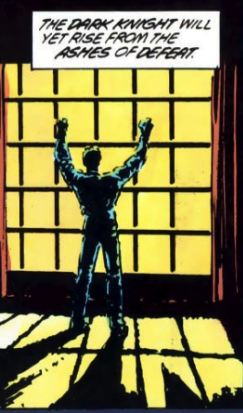I could make this post an epic big reveal about how Nolan pretty savagely riffed off of another (better) Batman comic by two comics creators who seldom see the respect they deserve. I prefer to count my blessings instead of my dumps, however, and am going to use their comparisons to talk about what makes Marvel’s cosmic creator and caretaker script one of the best Batman comics that a fantasy illustrator normally above such superheroics would deign to illustrate.
You see, by the time The Cult came out, Batman had already had a serious image overhaul. In the maniacally fascist and menacing scowl of Frank Miller’s Batman in The Dark Knight Returns, suddenly Batman jumped out of the pack and became the most stylish and deranged of all the normal superheroes. The same writer went and revised his origin to give it gangsters, prostitution, and law enforcement entanglement in Batman: Year One, and suddenly we were left with a very different hero than each month’s ongoing books displayed.
Jim Starlin answered the question quite nicely of what the contemporary Batman would look like if his will and sense of justice replaced his adventuring spirit and sense of humor.
He also gave a little bit more reason for Batman’s constant abandonment of everything; he made a damn imposing villain for our hero to face. Don’t stop me if this sounds familiar. A very intelligent and muscular man lures the homeless and desperate to his cause

be sure to click it if you want to read the passages describing how the Deacon persuaded an army of Gotham’s citizens to his side.
and organizes anarchy to the surface world from the sewer.
In a bold move that made this the first Batman comic boycotted by media [honestly, it should have a mature readers label, but doesn’t], Batman is not fighting just a very muscular man in these comics, he is fighting snipers from every window and sewer railing, knives from every alley. A very mature jump in a choice of villain for our hero when he normally faces an elaborately solipsistic deathtrap that the Joker would make, now the deathtrap doesn’t even let you know it’s a deathtrap.

Naturally, the army and government find the problem too dangerous to allow to spread, and too dangerous to investigate and neutralize. Not before they send a team of cops into the sewers to meet their fate from those who understand the battlefield.
If it’s not ringing any bells yet, and there are many more smaller ones to ring, after breaking free of his forced imprisonment, we see the words “The Dark Knight Will Yet Rise From The Ashes Of Defeat”
Jim Starlin has Batman learn something from being broken, something he forgot by the time Bane went on to break his back in Knightfall, and something he doesn’t learn in The Dark Knight Rises. He has spent his life telling himself that he became Batman out of revenge against his parents, but being battered and broken, and wanting to assume the mantle again from a city he’s unsure he can save, he realizes that he becomes Batman to face and conquer the fear he felt as a boy. Constantly stopping other muggings, he proves himself as able to overcome the initial trauma that he felt as a kid watching his parents get gunned down. He realizes this, and as long as he sees a situation with him helpless before another with a stronger weapon, he needs to overcome that fear or remain shaken by it.
It’s the kind of reanalysis that brings to mind the question of how this man can ever become fully sane. Heck, he even admits in this series that having a partner is probably not the safest option, and may even give him more reasons to justify his costumed adventuring.
The best part is, the comic kind of ends with him reapproaching that same fear, and beating The Deacon. Except, whereas Dark Knight Rises gave Batman a handsome death and a gorgeous babe while another inherited his legacy [Robin finding the lair], this comic allows Batman no escape. He overcomes the city, and feels the euphoria of overcoming his fear again. Heck, there’s even some oddly prescient captions about putting Jason’s life in danger to give him parents and a son that he saw die, and the end of the comic lets us know that Batman doesn’t just want to save the city. He wants to always be the one saving the city.
I think he learns how to make that a more enjoyable task, though, through these comics, by realizing how inevitable his altruism is.


